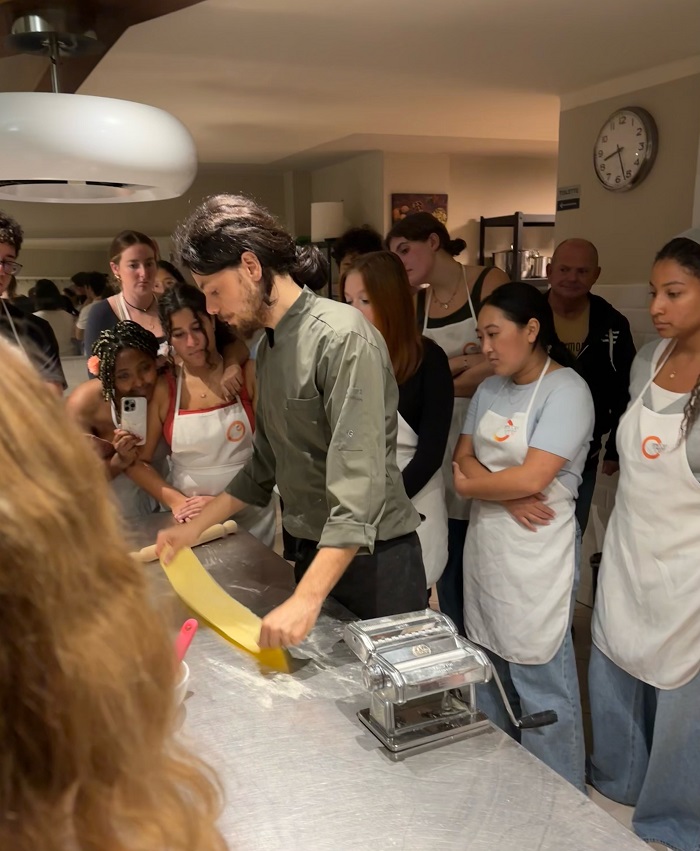Written by Heidi McGannon (Davidson College), Campus Ambassador for CET Florence
The Art of La Bella Figura
This past fall, in a grand yellow building overlooking the Arno River, I sat in a classroom with high, ornately frescoed ceilings and intricate tile floors, listening intently as my history professor described la bella figura. Though that crisp autumn day marked my first time hearing this phrase, the concept itself was no novelty to me. After all, I grew up watching with admiration as my grandfather, the son of Calabrese immigrants, dressed in a suit and tie not only on work days, but on the weekends as well. Well into his nineties, my grandfather valued presenting himself with grace and pride, a product of the Italian parents who raised him. My semester with CET Florence brought me the privilege of witnessing this uniquely Italian concept, among countless others, in action, and served as a catalyst for profound personal growth.
My professor explained that la bella figura, or “the beautiful figure” is a phrase which refers to the value Italians impart to proper presentation of oneself and the establishment of a positive impression, emphasizing dignity in behavior and appearance alike. That very afternoon, as I ventured from the CET Center to the nearby Basilica of Santa Croce with my drawing class, I observed la bella figura in action as I passed locals en route to work, school, or a leisurely lunch.
I began to observe the concept daily: from meandering through the charming stone roads of the city by day, to enjoying the lasting summer warmth on an early autumn evening over an aperitivo in my favorite piazza by night, I noticed myself admiring the grace of the Florentines, expressed through both fashion and attitude. I recall visiting an artist’s gallery opening at a villa in the Tuscan countryside just outside of Florence with a few CET friends. Although we were the only visitors at the villa that evening, the gracious host insisted on serving tea, coffee, and an array of appetizers. He emulated la bella figura not only through his neat attire, but also through his warmth and generosity, classically Italian qualities which stuck with me.

Immersion Within & Beyond the Classroom
As my coursework progressed throughout the semester, my perception of key facets of Italian lifestyle expanded beyond la bella figura. I was truly immersed in Florence, and the location of my apartment in the city center helped to provide an authentic experience, enabling my learning to take on a more nuanced dimension. Further, my classes nurtured a deep awareness and understanding of Italian values, as well as the history which shaped them, and this knowledge was an invaluable vehicle in helping me to become fully engrossed in the city.
Needless to say, I found the program’s focus on ensuring that students understand the culture and customs of their host country to be one of the most valuable aspects of the CET Florence curriculum. My classes provided a survey of information which, combined with various fantastic program excursions, fostered within students the greatest possible recognition of Florence’s value, from its art and architecture, to its food, to its athletic teams. Appreciative of the opportunity to take such a specialized course, I enrolled in my History of Modern Italy class, which brought me knowledge of la bella figura, though this is only one element of the in-depth comprehension I acquired of my host country. My coursework provided me with a holistic understanding of contemporary Italy, including its politics, culture, and customs, as well as the figures, traditions, and historical events which represent its framework, promoting growth by intrinsically expanding my worldview and perspective.
Learning Through Taste and Tradition
CET excursions allowed me to further take my learning beyond the classroom and truly become immersed in my environment. In history class, we discussed the pride Italians take in their cuisine, largely thanks to Pellegrino Artusi’s creation of a national cooking style in 1891 which combined regional varieties. Through this knowledge, I gleaned a new layer of appreciation for Italian delicacies. I understood what constituted Florentine specialities, such as pappardelle with boar ragu, so I always knew what was likely to be the best, most authentic item on the menu, avoiding tourist traps.



Additionally, I participated in cooking classes offered to my entire CET cohort, learning to make pasta and panna cotta from scratch. My learning went beyond Florence: when I traveled to Palermo, I knew to try arancini and cannoli. During a CET excursion to Rome, our entire program group enjoyed a traditional Roman dinner together, including cacio e pepe and amatriciana. My learning in the classroom allowed me to experience food, a key element of Italian culture, through the lens of a local, knowing what to try, where.
Another favorite CET activity for which my coursework cultivated a deep appreciation was our trip to a soccer game. My classmates and I had learned about and discussed the importance of athletics in Italian history, which brought a greater level of meaning as I cheered on Fiorentina during an exciting match. Further, my Beginning Italian Language course gave me the confidence to seamlessly navigate each of these opportunities in the most authentic possible manner.
In addition to serving as an invaluable tool during my time abroad as I navigated a new country and language. The knowledge I gained from the carefully designed CET curriculum stays with me today. I recognize that I had a uniquely immersive experience thanks to my learning, and my resulting broadened worldview is among the key facets of the growth I experienced thanks to my semester in Italy. I face new opportunities with an open mind and am eager to learn about unfamiliar cultures, cuisines, and values. I can confidently attribute the emergence and development of this trait to my semester of immersion in Italian culture inside and outside of the classroom alike.